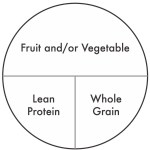Plate It Out: The Key to No-Stress Meals
May 11, 2015What and how you eat can increase your stress and stress can increase what and how you eat. In order to minimize this stress, it’s important to “Plate It Out” – a strategy for meals that improves your resiliency. Plate It Out and eating resiliently affect not only your physiology, but also your cognitive function. Your work performance, relationships, sleep, energy and health are all influenced by what you fuel your body with, and when you fuel it.
Going too long without eating triggers the stress response. Without adequate glucose to fuel our brain cells, our cognitive function is impaired, making it difficult to focus, concentrate and make good decisions. It also makes us highly emotional, resulting in impatience and negativity. Lack of glucose also makes us feel tired, sluggish and apathetic. Low blood glucose diminishes our ability to perform at our absolute best at work as well as at home.
Eating too much also increases stress. Large amounts of glucose require large amounts of insulin to be produced by the pancreas, placing stress on the organ. Eventually this stress can lead to diabetes. This excess glucose is stored in the fat cells, adding even more stress to the body.
Plate It Out helps you minimize the stress placed on your body and brain. By adding moderate amounts of glucose frequently throughout the day, you keep blood glucose levels within the body’s ideal range, you minimize stress, and set up your body and brain to function optimally.
HERE'S HOW TO PLATE IT OUT:
• Create a “T Plate” each time you eat a meal. One-quarter of your plate should be a source of lean protein, one-quarter whole gains, and the remaining one-half should consist of fruits and/or vegetables.

By hitting this 25/25/50 ratio at every meal, you provide your body with the wide variety of nutrients, vitamins, and minerals each day to function optimally and be well.
• Protein slows the release of blood glucose and will help you feel fuller for longer. It’s the anchor for each meal. Fruits and vegetables are high in fiber, which also slows the release of glucose into the bloodstream. Choose whole grains whenever possible as they contain more nutrients as well as fiber.
• Only eat to the point of feeling content, not stuffed. Feeling content means you’ve eaten enough food to last you about 3 hours (at which point in time you’ll have a small snack).
Examples of 60 Second T Plate meals:
Breakfast
• High-fiber, high protein cereal with milk and fresh berries
• Cottage cheese, whole grain crackers or bread, and cherry tomatoes
• Yogurt, granola, and fruit
Lunch
• Top some prewashed, bagged salad with canned beans or tuna, and have whole grain crackers or bread
• Fill a whole grain pita with turkey and bagged spinach
• Add hot water to soup in a cup that has protein, vegetables, and grains (Find natural, low sodium options)
Dinner
• Put a whole grain English muffin in the toaster; as soon as it's done, top with mozzarella cheese and a couple slices of tomato
• Microwave frozen vegetables, cut some store-bought rotisserie chicken, and have a whole grain dinner roll • Scramble two eggs, spoon on salsa and sliced avocado, and have a handful of corn tortilla chips
Learning to Plate It Out teaches you how to eat resiliently, which in turn minimizes stress on the body. When you Plate It Out, your body and brain are able to function optimally.
For more information on how nutrition affects your resiliency, performance and health along with strategies for improvement, read chapter four of Jenny's book The Resiliency rEvolution: Your Stress Solution for Life, 60 Seconds at a Time.
10 Micro Strategies to Boost Your Energy & Resilience
Instead of reaching for that candy bar or cup of coffee, here are 10 QUICK & EASY WAYS you can increase your energy and resilience by changing your chemistry and physiology.
Just let me know where you want me to send them.
We hate SPAM. We will never sell your information, for any reason.

